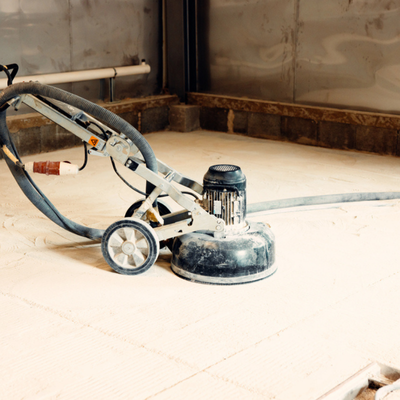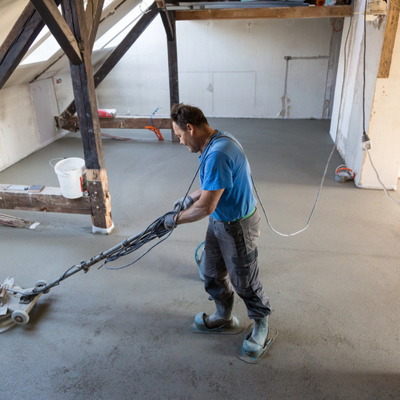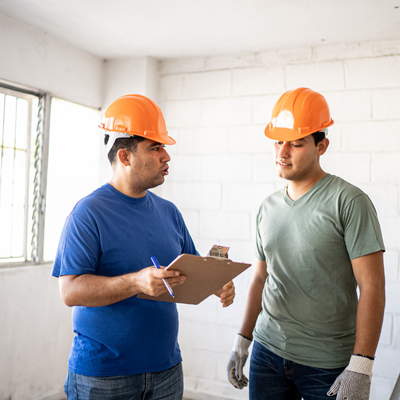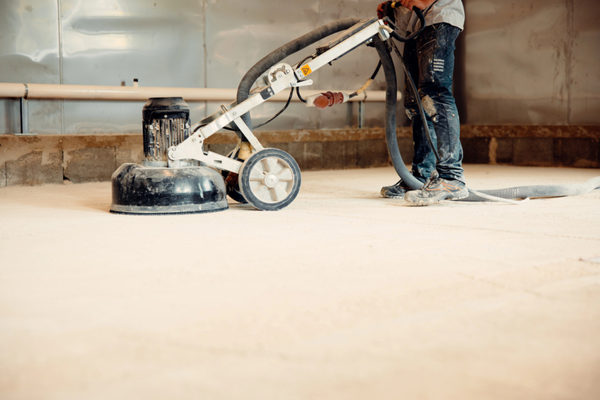Concrete floors have become popular in commercial and industrial spaces. They offer durability and modern style at a good price. When you need a concrete floor finish, two main flooring options stand out: grind and seal and polished concrete.
These concrete flooring systems look similar at first glance. But each floor finish type has a different installation process and performance. This summary explains both methods so you can pick the right concrete flooring treatment for your 2025 project.

Grind and seal starts with grinding the concrete surface. After surface preparation, workers apply a sealing process with a topical sealant. Common sealers include acrylic, epoxy, or urethane coatings that form a protective film.
This concrete floor resurfacing process takes less work than full polishing. Workers only do 1-2 grinding steps before sealing. The installation process moves faster and costs less upfront. You can get finishes from matte to gloss finish based on your sealer choice. Sealed concrete can reach various gloss levels, even a wet-look high shine.
The protective sealing layer wears down over time. Depending on foot traffic and sealer type, you may need recoating every few years. This method works great when you want a budget concrete finish that installs quickly.
Polished concrete is a concrete floor resurfacing process that refines the concrete itself. The polishing process uses progressively finer diamond tools through 7 or more steps. The concrete floor polishing creates a smooth surface with high reflectivity.
During polishing, contractors apply densifying agents that soak in and react with the concrete. This makes the surface harder and denser. The result is a dust-proof surface that shines without any coating.
Workers can control aggregate exposure from minimal to full reveal. They also adjust gloss levels from satin to high-gloss based on what you want. The polishing process takes more time and needs special equipment. That's why polished concrete costs more and takes longer than grind and seal floors. But you get a concrete finishing job that lasts decades.
Polished concrete gives you an elegant, natural look with mirror-like shine. It reveals the character of concrete, including marbling and aggregates. The shine from within often has deep clarity that improves room lighting.
Sealed concrete gets its shine from the applied sealer instead. A sealed concrete finish can be very glossy too. People call it a wet look that enriches the concrete's color. The sealer also hides small flaws, giving you more even color across the slab.
Both floor types offer different sheen finish options. Both methods offer great versatility for design. You can add color options with either system. Polished concrete can be stained or dyed during the polishing for colors and patterns.
Grind and seal allows tinted or colored sealers. You can even use decorative epoxy with pigment and flakes. With sealed floors, you can mix anti-slip additives into the topcoat for safety. Both floor types create beautiful concrete floor finishes with high shine.

When it comes to durability and handling wear and tear, these floors differ a lot. Polished concrete floors are known for top durability benefits in busy commercial spaces. The polishing and densifying process makes a surface with excellent abrasion resistance and scratch resistance.
The floor is literally the hardened concrete slab itself. A polished floor handles heavy foot traffic and daily use while keeping its shine for years. One limit is chemical resistance. Harsh chemicals or acids can penetrate the concrete if not cleaned fast.
Sealed concrete's durability depends on the sealer used. A high-quality sealer gives good stain resistance and chemical resistance. This protects against spills, oils, and many solvents. The sealer creates a barrier that stops liquids from soaking in.
But the sealer is a wear layer that shows wear and tear over time. In high-traffic zones, the coating can scuff or dull after years of use. For moisture resistance, both systems work well on properly prepped concrete. Polished concrete lets the slab breathe, so moisture vapor can escape.
Overall, polished concrete wins for pure toughness and longevity. Sealed concrete wins for chemical protection and versatility in harsh conditions.
Polished concrete has very low maintenance requirements. You just need regular cleaning and occasional buffing. There's no coating to replace. Most polished floors need only sweeping and mopping to look great for decades. This cuts down on maintenance costs over the floor's life.
Grind and seal needs more attention. The sealer layer requires periodic care to maintain its appearance. You may need to reapply sealing every 3-5 years depending on traffic and sealer type. This adds to the maintenance costs.
For slip resistance, sealed floors can include anti-slip additives in the final coat. Polished floors may get slippery when wet since their smooth surface has no texture.
Understanding Initial Investment and Long-Term Value
Cost is often the deciding factor. Grind and seal typically costs less upfront than polished concrete. The installation comparison favors grind and seal for speed too. This cuts labor costs and downtime.
But consider value over time. Polished concrete costs more upfront but needs no re-coating. So its maintenance costs stay low for decades. In spaces you plan to use long-term, polished concrete may cost less when you factor in lifetime maintenance costs.
If budget is the main concern and traffic isn't extreme, grind and seal is cost-effective. If you can invest more upfront for a premium finish, polished concrete pays off over time. Always get a detailed cost analysis from your contractor for both options.
Polished concrete offers exceptional durability and abrasion resistance. The floor can last decades with minimal upkeep, giving you great longevity. Low maintenance requirements mean no coatings to replace. The high-gloss appearance with impressive light reflectivity looks stunning.
You get design versatility with options for different aggregate exposures. The grinding consistency through the whole process ensures even results.
The main downside is higher upfront cost. The grinding process takes longer because of multiple steps. Chemical resistance is less since the uncoated surface can be hurt by harsh acids. High-gloss polished floors can be slippery when wet.
Lower initial cost and faster installation compared to polishing make this attractive. The protective sealer gives good stain resistance and chemical resistance to spills. Versatility in flooring finishing lets you achieve matte to high-gloss looks.
It's easier to achieve slip resistance by adding grit to the topcoat. This concrete finishing option works well on imperfect slabs.
The sealer shows wear and tear over time. It needs periodic reapplication to stay effective. You may need waxing or interim work to preserve gloss, raising maintenance costs. While initial shine is high, appearance can fade between reseals as coating wears down.

When deciding between grind and seal vs polished concrete, think about your specific needs. For busy commercial settings where durability matters, polished concrete is often worth the cost. Think retail stores, warehouses, or lobbies.
If your project has frequent liquid or chemical exposure, grind and seal with the right sealer can protect better. This works great for restaurant kitchens, auto shops, or factory floors. Sealed concrete is also smart when budget or time is tight.
Both polished and sealed concrete are concrete flooring systems that deliver strength and style. If you're still unsure which is best, talk to a professional contractor. They can provide an installation comparison for your conditions and do a cost analysis that includes lifetime maintenance costs.
Ready to transform your commercial space with a durable concrete floor? Contact Floor Doctor TX now for expert guidance on concrete floor resurfacing processes. We offer both polished concrete services and sealed concrete floor solutions for Texas businesses.
Get a free quote today and discover the perfect concrete flooring solution for your business. Call us or visit our website to schedule your consultation.
Grind and seal typically costs 30-50% less upfront than polished concrete. However, polished concrete has lower lifetime maintenance costs since it never needs recoating like sealed floors do.
The sealing process involves grinding the surface then applying a topical coating for protection. The polishing process mechanically refines the concrete itself through many grinding steps with progressively finer diamonds, creating shine from within the concrete rather than from a coating.
Polished concrete provides superior abrasion resistance because the surface is hardened concrete with no soft coating. Sealed concrete's abrasion resistance depends on the sealer used and will wear down faster in high-traffic areas.
Yes, both systems can achieve similar gloss levels from matte to high-gloss. Sealed concrete often has a wetter, glossier look from the coating while polished concrete has a deep, clear shine from the refined concrete surface itself.

